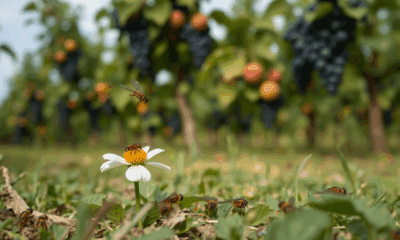While we try to keep things accurate, this content is part of an ongoing experiment and may not always be reliable.
Please double-check important details — we’re not responsible for how the information is used.
Botany
“Unlocking Plant Defenses: Researchers Develop RNA-Based Agents to Combat Cucumber Mosaic Virus”
New RNA-based active agents reliably protect plants against the Cucumber mosaic virus (CMV), the most common virus in agriculture and horticulture. They were developed by researchers at the Martin Luther University Halle-Wittenberg (MLU). The active ingredients have a broad spectrum effect; a series of RNA molecules support the plant’s immune system in combating the virus. In laboratory experiments, 80 to 100 per cent of the treated plants survived an infection with a high viral load, as the team reports in ‘Nucleic Acids Research’. Their paper has been selected as a ‘breakthrough article’ by the journal. The researchers are now working on transferring the idea from the laboratory into practice.

Ancient DNA
Unveiling the Dinosaur’s Menu: A Fossilized Time Capsule Reveals the Sauropod’s Diet 100 Million Years Ago
A prehistoric digestive time capsule has been unearthed in Australia: plant fossils found inside a sauropod dinosaur offer the first definitive glimpse into what these giant creatures actually ate. The remarkably preserved gut contents reveal that sauropods were massive, indiscriminate plant-eaters who swallowed leaves, conifer shoots, and even flowering plants without chewing relying on their gut microbes to break it all down.
Animals
“Uncovering Madagascar’s Secret Seed Spreader: The Humble Lizard”
After millions of years of evolutionary isolation, Madagascar developed an unparalleled array of wildlife, and recent research has uncovered an unsung ecological hero: the lizard. Though often dismissed in studies of seed dispersal, lizards in Madagascar have proven to be vital agents of endozoochory, consuming fruits and spreading the seeds of over 20 plant species. Surprisingly, their seed choices differ from those of the dominant lemurs, suggesting an unrecognized ecological role. Even more striking, these lizards persist in degraded environments where larger frugivores can t, hinting at their crucial function in restoring Madagascar s forests.
Agriculture and Food
Unlocking Nature’s Potential: Scientists Discover Key Molecule to Supercharge Plant Growth
Scientists have discovered that a molecule known for defending animal immune systems called itaconate also plays a powerful role in plants. Researchers showed that itaconate not only exists in plant cells but actively stimulates growth, such as making corn seedlings grow taller. This surprising crossover between plant and animal biology may unlock new, natural ways to boost agriculture and even improve human health.
-

 Detectors3 months ago
Detectors3 months agoA New Horizon for Vision: How Gold Nanoparticles May Restore People’s Sight
-

 Earth & Climate4 months ago
Earth & Climate4 months agoRetiring Abroad Can Be Lonely Business
-

 Cancer4 months ago
Cancer4 months agoRevolutionizing Quantum Communication: Direct Connections Between Multiple Processors
-

 Agriculture and Food4 months ago
Agriculture and Food4 months ago“A Sustainable Solution: Researchers Create Hybrid Cheese with 25% Pea Protein”
-

 Diseases and Conditions4 months ago
Diseases and Conditions4 months agoReducing Falls Among Elderly Women with Polypharmacy through Exercise Intervention
-

 Chemistry3 months ago
Chemistry3 months ago“Unveiling Hidden Patterns: A New Twist on Interference Phenomena”
-

 Albert Einstein4 months ago
Albert Einstein4 months agoHarnessing Water Waves: A Breakthrough in Controlling Floating Objects
-

 Earth & Climate3 months ago
Earth & Climate3 months agoHousehold Electricity Three Times More Expensive Than Upcoming ‘Eco-Friendly’ Aviation E-Fuels, Study Reveals





























